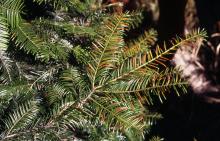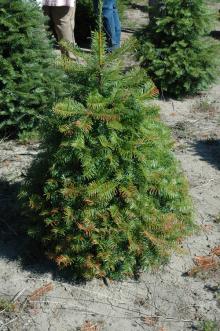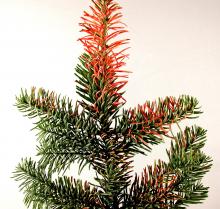Cause Sydowia polyspora (formerly Hormonema dematioides), a fungus, has been isolated from needles with current-season needle necrosis (CSNN) from a number of Abies spp., including noble and grand fir from the PNW. The exact role this fungus plays in disease development is unknown. It has become one of the most common needle diseases on these trees in the Pacific Northwest. There are site differences as well as considerable genetic variation among different sources of noble fir for development of this problem. Growers have noted the problem is not as great at higher elevations and in natural stands. Having the problem on more than 10% of the foliage is enough to cause a reduction in tree grade. Initial symptom development is associated with higher than normal temperatures during June.
Sydowia polyspora, a fungus, has been isolated from needles with current-season needle necrosis (CSNN) from a number of Abies spp., including noble and grand fir from the PNW. Limited inoculation trials have been conducted on small seedlings and the results have been variable. This fungus may just be an endophyte and not actually cause CSNN.
Symptoms Current-season needles develop brown to tan bands shortly after shoots elongate. Later these areas turn reddish-brown and may involve the whole needle. These needles are shed, but needles with banding remain on the tree. Worst on grand fir, not as bad on noble fir. Does not seem to be common on Nordmann fir. Not specific to any area of the grand fir tree but does occur more frequently on the upper portions of noble fir. Does not affect all trees in a group nor specific trees year after year. May be confused with needle rust, sunburn or heat stress, herbicide injury, and moisture stress.
Cultural control
- Some "Danish" sources of noble fir are more resistant to CSNN than Pacific Northwest sources that are typically use for Christmas trees. Testing of Nordmann and Turkish fir trees also indicates there are sources of more resistant types.
- Growing trees under shade has been helpful in some cases.
Chemical control Fungicides have been ineffective. Foliar applications of calcium chloride during shoot elongation reduce incidence of symptomatic needles; however, this is not recommended because it can burn needle tips. Various fertility programs have also not been effective in reducing symptom development.
References Hansen, E.M., Lewis, K.J., and Chastagner, G.A. 2018. Compendium of Conifer Diseases. St. Paul, MN: APS Press.
Talgø, V., Chastagner, G., Thomsen, I.M., Cech, T., Riley, K., Lange, K., Klemsdal, S.S., and Stensvand, A. 2010. Sydowia polyspora associated with current season needle necrosis (CSNN) on true fir (Abies spp.). Fungal Biology 114: 545-554.




